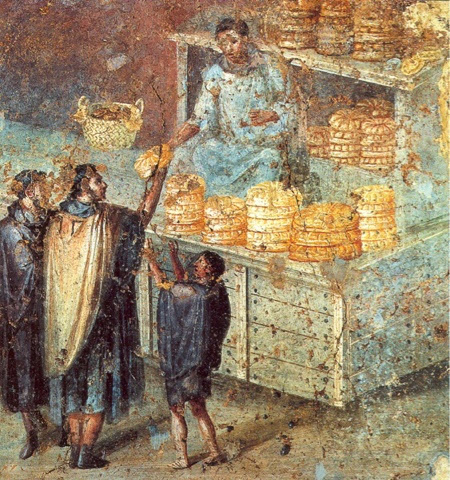How much was Roman money worth, and the problem of inflation.
When I first tutored introductory Roman history, a student asked me how much was money in Rome worth.
My response was, can I get back to you next week?
I then spent some frantic days trying to find the answer. I found I had a huge problem, and its name was inflation. All the studies were old and either from England or the United States, published just after WWII which was completely useless for an Australian class in 2002.
So I put my thinking cap on and tried to conceive a way to answer this question removing the issues of inflation and different currencies. The answer struck me at my favourite bakery - bread.
This topic recently arose in a discussion the other day and I promised to find my calculation and share the results. Surprisingly, the page on which I had figured this out was exactly where I thought it was, but I hadn't written any of the references. This worked out well, because I found some errors when I re-examined my calculations and sought out references.
Following the fire of Rome in AD 64, wheat was being sold in Rome for 3 sesterces per modius according to Tacitus Annals XV.39. According to Tenney Frank's An Economic History of Rome p. 403, this was a low price generated to deal with the tragedy. According to Bradley Hudson McLean An Introduction to Greek Epigraphy of the Hellenistic and Roman Periods from Alexander the Great down to the Reign of Constantine (323 B.C. - A.D. 337) p. 375 this was the standard price in 150 B.C., so this gives an idea of how this price fits into Roman prices historically.
Most of the wheat for sale in Rome and Italy in this period was from Egypt, so my calculations are based on Pliny the Elder's description of how much bread could be made out of wheat from Egypt. Depending on where the within Egypt the wheat came from one modius of wheat (8.62 litres) could be milled and prepared to yield 25-26 Roman pounds of bread, according to Pliny Natural History 18.12.68.
One Roman pound (libra or pondus) weighs 327.45 grams according to the Oxford Encyclopedia of Ancient Greece and Rome.
So, if 1 modius of wheat cost 3 sesterces, it cost 12 asses, an as being the smallest Roman bronze coin. For the sake of my calculation I used the 26 pounds of bread which Pliny suggested could be made from the wheat from around Thebes in Upper Egypt.
26 Roman pounds x 327.45 grams = 8 kilos 513.7 grams of bread.
8513.7 grams of bread divided by the 12 asses its wheat cost = 709.475 grams/as.
Therefore, following the fire of Rome in A.D. 64, the smallest valued coin in Rome could purchase enough wheat to bake a little over 700 grams of bread, the standard loaf size sold in Australia.
This price was an emergency reduction in price, and thus probably didn't last long, especially once civil war broke out following Nero's death in A.D. 68.
To place this into context, Tenney Frank suggests a soldier's pay was 225 denarii annually or 10 asses a day around this time. The Oxford Encyclopedia of Ancient Greece and Rome suggests that a laborer's daily was was 4 sesterces (or 16 asses) a day. The disparity between the two might be the result of the provision of meals to soldiers.
You should also remember that this was not the cost of bread, but the cost of wheat from which to make bread. Other ingredients and the baker would have increased the price.
 |
| Bakery fresco from Naples Museum |


Comments
Post a Comment